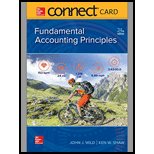
Connect Access Card For Fundamental Accounting Principles
24th Edition
ISBN: 9781260158526
Author: John J Wild
Publisher: McGraw-Hill Education
expand_more
expand_more
format_list_bulleted
Textbook Question
Chapter 2, Problem 22E
Exercise 2-22 Calculating and interpreting the debt ratio A2
| Company | Expenses | Total Assets | Met Income | Total Liabilities |
| DreamWorks | $22,000 | $ 40.000 | $19,000 | $30,000 |
| Pixar | 67,000 | 150.000 | 27,000 | 147,000 |
| Universal | 12.000 | 6S.OO0 | 5.00C | 17,000 |
a. Compute the debt ratio for each of the three companies.
b. Which company has the most financial leverage?
Expert Solution & Answer
Want to see the full answer?
Check out a sample textbook solution
Students have asked these similar questions
In determining whether § 357(c) applies, assess whether the liabilities involved exceed the bases of all assets a shareholder transfers to the corporation./ Provide explanation please. a. True b. False
I will unhelpful if wrong.
please don't solve using wrong values i will mark as unhelpful.
Chapter 2 Solutions
Connect Access Card For Fundamental Accounting Principles
Ch. 2 - Prob. 1DQCh. 2 - What is the difference between a note payable and...Ch. 2 - Prob. 3DQCh. 2 - What kinds of transactions can be recorded in a...Ch. 2 - Are debits or credits typically listed first in...Ch. 2 - Should a transaction be recorded first in a...Ch. 2 - If assets are valuable resources asset accounts...Ch. 2 - Prob. 8DQCh. 2 - Prob. 9DQCh. 2 - Identify the four financial statements of a...
Ch. 2 - Prob. 11DQCh. 2 - Prob. 12DQCh. 2 - Prob. 13DQCh. 2 - Prob. 14DQCh. 2 - Prob. 15DQCh. 2 - Prob. 16DQCh. 2 - Prob. 17DQCh. 2 - Prob. 18DQCh. 2 - Identifying source documents C1 Identify the items...Ch. 2 - Identifying financial statement accounts C2...Ch. 2 - Reading a chart of accounts C3 A chart of accounts...Ch. 2 - Identifying normal balance C4 Identify the normal...Ch. 2 - QS 2–5
Linking debit or credit with normal...Ch. 2 - Prob. 6QSCh. 2 - Analyzing debit or credit by account A1 Identify...Ch. 2 - Prob. 8QSCh. 2 - Prob. 9QSCh. 2 - Prob. 10QSCh. 2 - Preparing journal entries P1 Prepare general...Ch. 2 - Preparing an income statement P3 Liu Zhang...Ch. 2 - Preparing a statement of owner's equity P3 Use the...Ch. 2 - Prob. 14QSCh. 2 - Prob. 15QSCh. 2 - Exercise 21 Steps in analyzing and recording...Ch. 2 - Prob. 2ECh. 2 - Exercise 2-3 Identifying a ledger and chart of...Ch. 2 - Prob. 4ECh. 2 - Prob. 5ECh. 2 - Prob. 6ECh. 2 - Prob. 7ECh. 2 - Exercise 28 Preparing Taccounts (ledger) and a...Ch. 2 - Prob. 9ECh. 2 - Exercise 2-10 Preparing a trial balance P2 After...Ch. 2 - Prob. 11ECh. 2 - Prob. 12ECh. 2 - Exercise 2-13 Entering transactions into...Ch. 2 - Exercise 2-14 Preparing general journal entries P1...Ch. 2 - Prob. 15ECh. 2 - Prob. 16ECh. 2 - Prob. 17ECh. 2 - Prob. 18ECh. 2 - Prob. 19ECh. 2 - Prob. 20ECh. 2 - Prob. 21ECh. 2 - Exercise 2-22 Calculating and interpreting the...Ch. 2 - Exercise 2-23 Preparing journal entries P1 Prepare...Ch. 2 - Prob. 1APSACh. 2 - Prob. 2APSACh. 2 - Prob. 3APSACh. 2 - Prob. 4APSACh. 2 - Prob. 6APSACh. 2 - Prob. 7APSACh. 2 - Prob. 1BPSBCh. 2 - Prob. 2BPSBCh. 2 - Prob. 3BPSBCh. 2 - Prob. 4BPSBCh. 2 - Problem 2-5B Computing net income from equity...Ch. 2 - Prob. 6BPSBCh. 2 - Problem 2-7B Preparing an income statement,...Ch. 2 - SP 2 On October 1, 2019, Santana Rey launched a...Ch. 2 - Using transactions from the following assignments...Ch. 2 - Prob. 2GLPCh. 2 - Prob. 3GLPCh. 2 - Prob. 4GLPCh. 2 - Prob. 5GLPCh. 2 - Prob. 6GLPCh. 2 - Prob. 7GLPCh. 2 - Prob. 8GLPCh. 2 - Refer to Apple's financial statements in Appendix...Ch. 2 - Prob. 2AACh. 2 - Key comparative figures for Apple, Google, and...Ch. 2 - Prob. 1BTNCh. 2 - Prob. 2BTNCh. 2 - Prob. 3BTNCh. 2 - Prob. 4BTNCh. 2 - Prob. 5BTNCh. 2 - Prob. 6BTNCh. 2 - Prob. 7BTN
Knowledge Booster
Learn more about
Need a deep-dive on the concept behind this application? Look no further. Learn more about this topic, accounting and related others by exploring similar questions and additional content below.Similar questions
- Bansai, age 66, retires and receives a $1,450 per month annuity from his employer's qualified pension plan. Bansai made $87,600 of after-tax contributions to the plan before retirement. Under the simplified method, Bansai's number of anticipated payments is 240. What is the amount includible in income in the first year of withdrawals assuming 12 monthly payments? A. $10,560 B. $12,540 C. $17,400 D. $8,220arrow_forwardWhat is the cost of goods sold?arrow_forwardCan you help me find the accurate solution to this financial accounting problem using valid principles?arrow_forward
arrow_back_ios
SEE MORE QUESTIONS
arrow_forward_ios
Recommended textbooks for you
 Corporate Financial AccountingAccountingISBN:9781305653535Author:Carl Warren, James M. Reeve, Jonathan DuchacPublisher:Cengage Learning
Corporate Financial AccountingAccountingISBN:9781305653535Author:Carl Warren, James M. Reeve, Jonathan DuchacPublisher:Cengage Learning

Corporate Financial Accounting
Accounting
ISBN:9781305653535
Author:Carl Warren, James M. Reeve, Jonathan Duchac
Publisher:Cengage Learning
Financial ratio analysis; Author: The Finance Storyteller;https://www.youtube.com/watch?v=MTq7HuvoGck;License: Standard Youtube License